Algae are classified into 3 groups.
Chlorophycea
The class Chlorophycea is composed of a large group of freshwater green algae. They can be unicellular, colonial or filamentous. They appear grass-green in colour due to the presence of chlorophyll a and b. Some of the common members of this group are Chlamydomonas, Volvox, Ulothrix, Spirogyra and Chara.
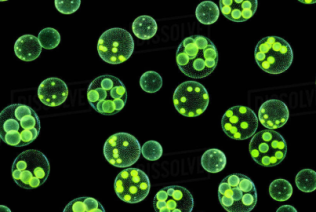
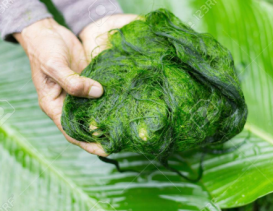
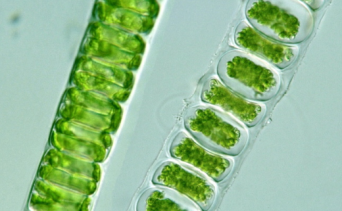
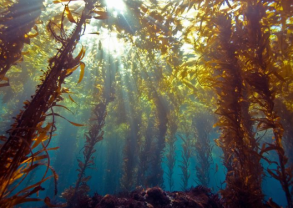
Volvox Spirogyra Ulothrix Kelps
Cell structure:
They have a rigid cell wall composed of two layers. The inner layer is made up of cellulose, and the outer layer is made up of pectose. The chlorophyll is present in the chloroplasts. Chloroplast may be cup shaped, discoid, reticulate, spiral, plate – like or ribbon shaped in different species. The cell contains storage bodies known as pyrenoids. It contains protein and starch. Some species have stored food in the form of oil droplets.
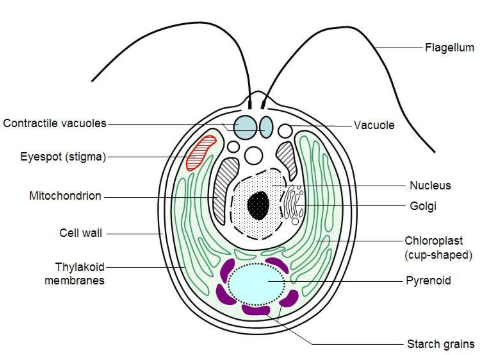
Reproduction:
- Vegetative reproduction occurs through fragmentation (eg. Spirogyra).
- Asexual reproduction involves the formation of zoospores.
- Sexual reproduction is highly varied among the members. It may be isogamous, anisogamous and oogamous.
Economic Importance:
Some of the members of chlorophycea are important both economically and scientifically. For example, Chlamydomonas and Volvox are widely used as model organism in researches.
- Chlamydomonas – used in various studies such as freshwater ecology, cell division, genetic structure, genomic evolution, cell physiology etc.
- Volvox – used in studying cell death (apoptosis) and cell interactions.
Phaeophycea
The phaeophytes are the largest of the group algae. All the members of this group are marine. Their form and size varies largely. Some are simple, branched, filamentous forms (eg. Ectocarpus), while others are profusely branched forms (eg. Kelps). Their color also varies from olive green to various shades of brown depending on the amount of pigments present in them. The main pigments found in them are chlorophyll a, c, carotenoids and xanthophylls.Common members of this group are Ectocarpus, Dictyota, Laminaria, Sargassum and Fucus.
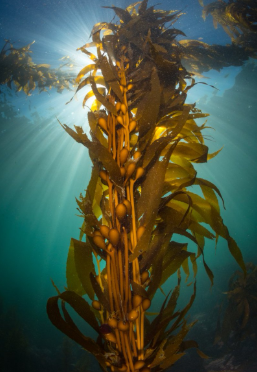
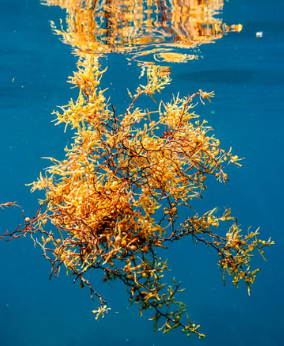
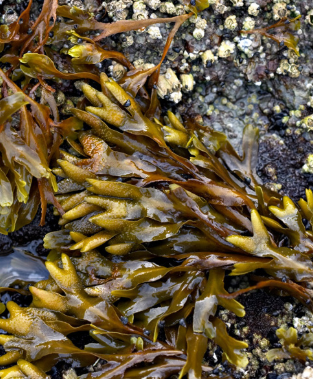
Laminaria Sargassum Fucus
Cell structure
The plant body consists of a stalk, a stipe and the frond (leaf – loike photosynthetic organ). It attaches to the substratum by means of a holdfast. The vegetative cell has a three layered pectic – cellulosic cell wall. The cell wall is covered externally by a gelatinous coating of algin. Cell contains plastids, a centally located vacuole and a nucleus.
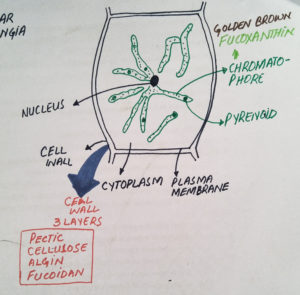
Plastids contain the secondary pigments. Chlorophyll c is a modified form of plant chlorophyll. The carotenoids are brown or golden colored pigments. The variation in color of phaeophytes is influenced by the amount of the xanthophyll pigment fucoxanthin. Food is stored in the form of complex carbohydrates such as laminarin or mannittol.
Reproduction:
- Vegetative reproduction takes place by means of fragmentation.
- Asexual reproduction involves production of biflagellate zoospores (pear shaped).
- Sexual reproduction: it may be isogamous, anisogamous, or oogamous. Fusion of gametes takes place in water or in the oogonium.
Rhodophycea
Members of this group are generally called red algae. They appear red due to the presence of the pigment phycoerythrin. Most of the rhodophytes are marine, and occur mostly in warm regions. They are found at water surfaces as well as at greath depths of oceans. Common members of this group are Polysiphonia, Porphyra, Gracilaria, Gelidium etc.
Cell structure:
Very few rhodophtes are unicellular. Most of them are multicellular and appear either in filamentous form or as membranous sheet form. Some of them are coralline, and deposits their skeletons (containing calcium carbonate crystals) to form reefs. Food is stored in the form of floridean starch. Cell wall is covered by a slimy outer sheath. Colloidal compounds such as agars and carageenan are also presnt in the cell wall.
The red color of the rhodophytes is due to the presence of phycoerythrin. This pigment absorbs blue light and reflects most of the red light. Since the blue light can reach at great depths, the rhodophtes are seen even at the deepest parts of the ocean. Some rhodophyes have very little phycoerythrin, and they appear blue or green due to the chlorophyll and other pigments in them.
Reproduction:
- Vegetative reproduction: By fragmentation.
- Asexual reproduction: By formation of non- motile spores
- Sexual reproduction: Oogamous, followed by post – fertilization events.
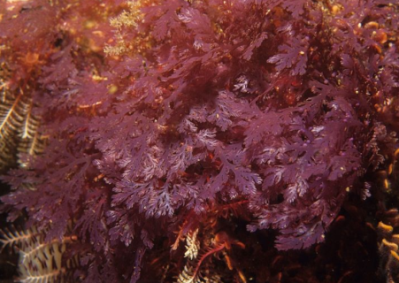
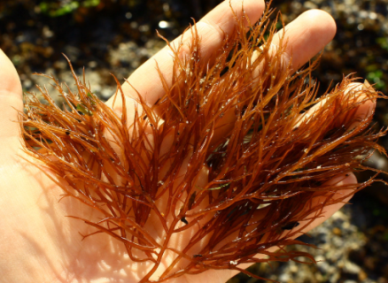
Gelidium Gracillaria